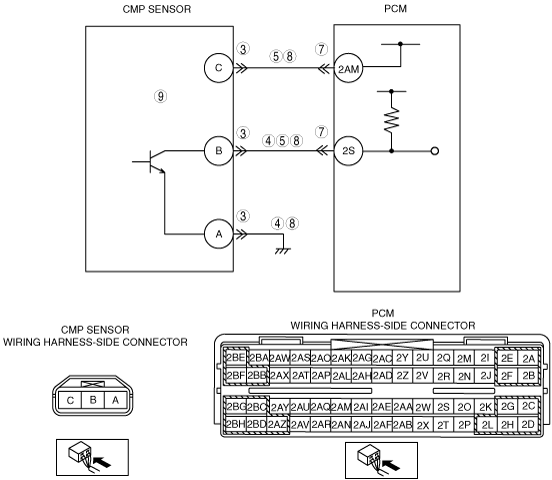|
1
|
VERIFY FREEZE FRAME DATA AND DIAGNOSTIC MONITORING TEST RESULTS HAS BEEN RECORDED
• Has FREEZE FRAME DATA been recorded?
|
Yes
|
Go to the next step.
|
|
No
|
Record the FREEZE FRAME on the repair order, then go to the next step.
|
|
2
|
VERIFY RELATED REPAIR INFORMATION AVAILABILITY
• Verify related Service Information availability.
• Is any related Service Information available?
|
Yes
|
Perform repair or diagnosis according to the available Service information.
If the vehicle is not repaired, go to the next step.
|
|
No
|
Go to the next step.
|
|
3
|
INSPECT CMP SENSOR CONNECTOR FOR POOR CONNECTION
• Verify that the CMP sensor connector is connected securely.
• Is the connector normal?
|
Yes
|
Go to the next step.
|
|
No
|
Reconnect the connector, then go to Step 14.
|
|
4
|
INSPECT CMP CIRCUIT FOR SHORT TO POWER
• Turn the ignition switch off.
• Disconnect the CMP sensor connector.
• Turn ignition switch to the ON position (Engine off)
• Measure voltage between the CMP sensor connector terminal B (wiring harness-side) and body ground.
• Is the voltage B+?
|
Yes
|
Repair or replace the suspected wiring harness, then go to Step 14.
|
|
No
|
Go to the next step.
|
|
5
|
INSPECT CMP CIRCUIT FOR SHORT TO GROUND
• Inspect for continuity between the following terminal and body ground:
-
― CMP sensor connector terminal B (wiring harness-side)
― CMP sensor connector terminal C (wiring harness-side)
• Is there continuity?
|
Yes
|
Repair or replace the suspected wiring harness, then go to Step 14.
|
|
No
|
Go to the next step.
|
|
6
|
INSPECT CMP CIRCUITS FOR SHORT CIRCUIT
• Inspect for continuity between CMP sensor connector terminals B and C (wiring harness-side).
• Is there continuity?
|
Yes
|
Repair or replace the suspected wiring harness, then go to Step 14.
|
|
No
|
Go to the next step.
|
|
7
|
INSPECT PCM CONNECTOR FOR POOR CONNECTION
• Disconnect the PCM connector.
• Inspect for poor connection (damaged, pulled-out terminals, corrosion, etc.).
• Is there any malfunction?
|
Yes
|
Repair the terminal, then go to Step 14.
|
|
No
|
Go to the next step.
|
|
8
|
INSPECT CMP CIRCUIT FOR OPEN CIRCUIT
• Inspect for continuity between the following circuits:
-
― CMP sensor terminal A (wiring harness-side) and body ground
― CMP sensor terminal B (wiring harness-side) and PCM terminal 2S (wiring harness-side)
― CMP sensor terminal C (wiring harness-side) and PCM terminal 2AM (wiring harness-side)
• Is there continuity?
|
Yes
|
Go to the next step.
|
|
No
|
Repair or replace the suspected wiring harness, then go to Step 14.
|
|
9
|
INSPECT CMP SENSOR
• Turn the ignition switch off.
• Perform the CMP sensor inspection.
• Is the CMP sensor normal?
|
Yes
|
Go to the next step.
|
|
No
|
Replace the CMP sensor and go to Step 14.
|
|
10
|
VERIFY CKP SENSOR INSTALLATION
• Verify the CKP sensor installation.
• Is the CKP sensor installed correctly?
|
Yes
|
Go to the next step.
|
|
No
|
Reinstall the CKP sensor and go to Step 14.
|
|
11
|
VERIFY VALVE TIMING MECHANISM INSTALLATION
• Verify the valve timing mechanism installation for the following parts:
-
― Timing chain misinstallation
― Loose camshaft sprocket lock bolt
― Loose crankshaft pulley lock bolt
• Is the valve timing mechanism installed correctly?
|
Yes
|
Go to the next step.
|
|
No
|
Reinstall the following parts and go to Step 14.
• Timing chain
• Camshaft sprocket
• Crankshaft pulley
|
|
12
|
INSPECT STOPPER PIN MECHANISM (LF, L3)
• Remove the timing chain.
• Inspect the stopper pin.
• Is the stopper pin mechanism normal?
|
Yes
|
Go to the next step.
|
|
No
|
Replace the variable valve timing actuator, then go to Step 14.
|
|
13
|
INSPECT ROTOR POSITION (LF, L3)
• Remove the variable valve timing actuator.
• Is the rotor position at the maximum valve timing retard?
|
Yes
|
VARIABLE VALVE TIMING MECHANISM NORMAL
-
Note
-
• This DTC is detected as an intermittent concern.
• The intermittent concern might be removed by cleaning the variable valve timing mode control function.
Go to the next step.
|
|
No
|
Replace the variable valve timing actuator, then go to the next step.
|
|
14
|
VERIFY TROUBLESHOOTING OF DTC P0340 COMPLETED
• Make sure to reconnect all disconnected connectors.
• Turn ignition switch to the ON position (Engine off).
• Clear the DTC from the PCM memory using the WDS or equivalent.
• Start the engine.
• Access the MAF PID using the WDS or equivalent.
-
Note
-
• The MAF PID should indicate 1.95 g/s {0.25 lb/min.} or above during this test
• Is same DTC present?
|
Yes
|
Replace the PCM, then go to the next step.
|
|
No
|
Go to the next step.
|
|
15
|
VERIFY AFTER REPAIR PROCEDURE
• Perform the “After Repair Procedure”.
• Are any DTCs present?
|
Yes
|
Go to the applicable DTC inspection.
|
|
No
|
Troubleshooting completed.
|
